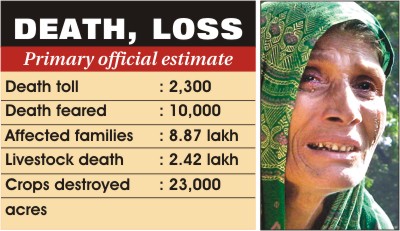Red Crescent fears toll may top 10,000

A mother with tearful eyes stares at the Bay of Bengal at Roshangiri in Banshkhali, Chittagong, yesterday hoping her missing son will return. Her son went fishing near Dublarchar in Bagherhat before the storm.Photo: Focus Bangla
Fears were growing last night that the true scale of destruction wreaked by Cyclone Sidr could be much graver than previously thought, with the government raising the official death toll to 2,299 and the Red Crescent forecasting causalities as high as 10,000. "We have already identified 2,750 bodies. Based on our experience in the past and reports from the scene, I would suggest the death toll may be as high as 10,000," Prof M Abdur Rob, chairman of the Bangladesh Red Crescent Society, told press in city yesterday, four days into the catastrophe. The government rescuers recovered 515 more bodies in 24 hours from 1:30am Sunday, with Barguna overtaking Bagerhat as the district with the highest death toll of 717. Shell-shocked survivors and rescuers yesterday picked through the cyclone ruins in the worst-hit southern districts as thousands of victims awaited relief amid their wrecked homes, crops, livestock and fields. They sobbed in agony, suffered from hunger, thirst and diarrhoea. They buried dear ones and searched in vain for the answer why fate conspired against them. "This cyclone has left me with a wasteland," groaned 55-year-old Anwar Hossain Monwar from East Katakhali village in Barguna. He had everything-- a loving family of 5, 2 houses, a mosque built by him and a fish farm. "I lost everything, overnight, except for the ruined land," sobbed Anwar while talking with The Daily Star. Reacting to the concern of the Red Crescent, which deployed around 42,000 volunteers in the coastal areas, Mohammad Aiyub Miah, acting secretary to the food and disaster management ministry, said, "It is hard to guess what could be the possible number of causalities. We can assure the public that we will instantly update all on the death toll, however grave it turns out to be." The government expects to prepare an estimate of damage by the end of this week, as the extent of destruction was too severe to assess quickly. "We have been taken aback with the catastrophe in some remote, inaccessible areas. It will take time for us to get an idea of the actual loss there," Aiyub Miah told The Daily Star last night. The government hoped to place a detailed report on causalities and financial loss at next week's meeting with international donors, who have already pledged around $25 million in aid. Thousands of troops are now working along side volunteers and Coast Guards, searching for survivors and distributing relief. "Although we could not reach some places physically, we have airdropped relief materials in those areas," General Staff Officer-1 of Armed Forces Division (AFD) Lt Col Mainullah Chowdhury said at a press briefing yesterday. Meanwhile, people of Barguna, where the death toll doubled overnight, found no end to their miseries. Staying out under the open sky, thousands of survivors are now begging for a glass of water, highlighting the lack of even the most basic relief supplies. "We used to rely on tubewells and ponds for drinking water. All the 16 tubewells in my union parishad went out of order and ponds became reservoirs of salty waters after the tidal surge," said Sultan Mahmud, chairman of a Noltona union parishad over the phone last evening. Scarcity of relief was also reported from many parts of the storm-hit districts. About 30,000 people were affected out of 36,000 residents at Sultan's union. "So far, we have received 10 metric tone rice and Tk 10,000 in government relief and this could only be distributed among 2,500 people," he said. The disaster management control room updated its rough estimate of losses caused by Sidr that will be a severe blow to the economy, which is already suffering huge losses from back-to-back floods in the middle of this year. The cyclone left its mark of devastation on 133 upazilas, 962 unions, affecting 31.44 lakh population of about 8.87 lakh families. The storm killed 2.42 lakh livestock and completely destroyed crops on 23,122-acre land including six lakh metric tons of Aman. According to the estimate, 2.73 lakhs houses were totally flattened, with 58km roads totally destroyed and another 1,363km damaged. The shrimp farms at the badly-hit Morolgonj and Sharankhola upazilas in Bagherhat were extensively damaged, with the financial loss expected to reach Tk 500cr. According to the latest government toll, the cyclone killed 717 in Barguna, 610 in Bagerhat, 330 in Patuakhali, 285 in Pirojpur, 85 in Barisal, 34 in Jhalakathi, 38 in Madaripur, 31 in Bhola, 29 in Gopalganj, 17 in Shariatpur, 16 in Satkhira, 15 in Khulna, 11 in Faridpur, four each in Dhaka, Chandpur, and Munshiganj, and two each in Laxmipur, and Narayanganj, one each in Jessore, Chittagong, Rajbari, Narsingdi, and Narail. Meanwhile, echoing the concerns of Red Crescent, different non-government organisations also urged the international community to stand by disaster-hit Bangladeshis. "These people are very poor and have lost everything. Their need will be very high, and we don't believe the Bangladesh government can help all of them," said a top man in international relief agency. The international community hailed the government's disaster preparedness, which greatly helped reduce causalities as well as losses. However Juliet Parker of Christian Aid cautioned, "These preparations saved lives but not livelihoods."


 For all latest news, follow The Daily Star's Google News channel.
For all latest news, follow The Daily Star's Google News channel. 



Comments